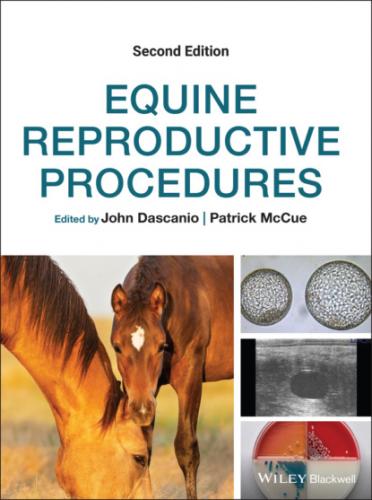The four most common bacterial pathogens of the equine uterus are Streptococcus equi subspecies zooepidemicus, Escherichia coli, Klebsiella pneumoniae, and Pseudomonas aeruginosa.
Streptococcus equi subspecies zooepidemicus are Gram‐positive cocci approximately 1.0 μm in diameter that form chains of various length (Figure 17.7).
Escherichia coli, K. pneumoniae, and P. aeruginosa are Gram‐negative rods varying in size from 3 to 6 μm in length and cannot be differentiated accurately based on cytologic evaluation (Figure 17.8).
Fungal Organisms
Yeast are typically 5–8 μm in size with a very distinct cell wall (100–200 nm) that forms a clear “halo” around the organism; this may be especially evident if the organism is surrounded by debris or other cells (Figure 17.9).
Hyphate fungi are typically 3–5 μm in width and 8 μm in length. These individual cells are commonly linked together in long branching chains (Figures 17.10 and 17.11). In many instances, detection of a fungal organism on cytologic examination may be the only evidence of fungal endometritis, as organisms do not always grow on culture.
Figure 17.7 Chains of cocci (arrow) in a uterine cytology sample collected from a mare with a Streptococcus equi subspecies zooepidemicus infection.
Figure 17.8 Gram‐negative rods (arrow) in a uterine cytology sample collected from a mare with endometritis.
Figure 17.9 Yeast organisms (Candida albicans) (arrow) in a uterine cytology sample.
Figure 17.10 Aspergillus fumigatus organisms in a mare with fungal endometritis.
Figure 17.11 Yeast (large arrow) and hyphae (small arrow) with neutrophils in a mare with fungal endometritis.
Further Reading
1 Bourke M, Mills JN, Barnes AL. 2008. Collection of endometrial cells in the mare. Aust Vet J 75: 755–8.
2 Brook D. 1993. Uterine cytology. In: McKinnon AO, Voss JL (eds). Equine Reproduction. Philadelphia: Lea and Febiger, pp. 246–54.
3 Couto MS, Hughes JP. 1984. Technique and interpretation of cervical and endometrial cytology in the mare. J Eq Vet Sci 4: 265–73.
4 Dascanio J, Ley WB, Bowen JM. 1997. How to perform and interpret uterine cytology. Proc Annu Conv Am Assoc Eq Pract 43:182–6.
5 Riddle W, Leblanc M, Stromberg A. 2007. Relationships between uterine culture, cytology and pregnancy rates in a Thoroughbred practice. Theriogenology 68(3): 395–402.
18 Uterine Culture/Cytology: Low Volume Lavage
John J. Dascanio
School of Veterinary Medicine, Texas Tech University, USA
Introduction
Typically a double‐guarded swab or a brush is used to obtain a sample for uterine culture or cytology. However, a low volume uterine lavage may be more diagnostic in situations where localized uterine infections are present or if an infection is suspected and no microbial growth was obtained after collection of a uterine sample with a guarded swab. The goal is to have the lavage fluid distribute throughout the uterine lumen and therefore “sample” the entire uterus instead of one specific region as would occur with a traditional swab. The negative aspects of performing a low volume uterine lavage are the extra time required to perform the procedure, the possibility of contamination since the tubing is not guarded, the need to have sterilized lavage tubing, and the centrifugation step used to concentrate the cellular material in the effluent.
Equipment and Supplies
Tail wrap, tail rope, non‐irritant soap, roll cotton, stainless steel bucket, disposable liner for bucket, paper towels, obstetrical sleeve, obstetrical lubricant, examination gloves, sterile lubricant, sterile obstetrical sleeve, sterile 80 cm (30 inch) uterine lavage catheter, sterile single‐line tubing, 50 ml centrifuge tubes, 150 or 250 ml sterile 0.9% sodium chloride or phosphate‐buffered saline, catheter tipped 60 ml syringe, 60 ml syringe, microscope slides, Diff‐Quik® stain, microscope, centrifuge, oxytocin, needles and syringes.
Technique
Remove feces from the rectum.
Place a tail wrap and tie the tail out of the way (see Chapter 4).
Clean and dry the perineum of the mare (see Chapter 3).
Don a sterile obstetrical sleeve.
Place the end of an 80 cm uterine lavage catheter with a deflated 75 ml cuff into the palm of the hand.
A 150–250 ml bag of 0.9% sodium chloride can be attached directly to the catheter and the catheter is filled prior to placement. This prevents air influx into the uterus and allows for better recovery of the lavage fluid. Alternatively, sterile, single‐line tubing can be used to connect the bag of saline to the lavage catheter (Figure 18.1).
Place sterile lubricant on the back of the gloved hand, being careful not to get lubricant onto the palm. If the end of the lavage tubing becomes inundated with lubricant, the lubricant may get into the sample thus interfering with interpretation of the cells.
Rub lubricant from the knuckles on to the
